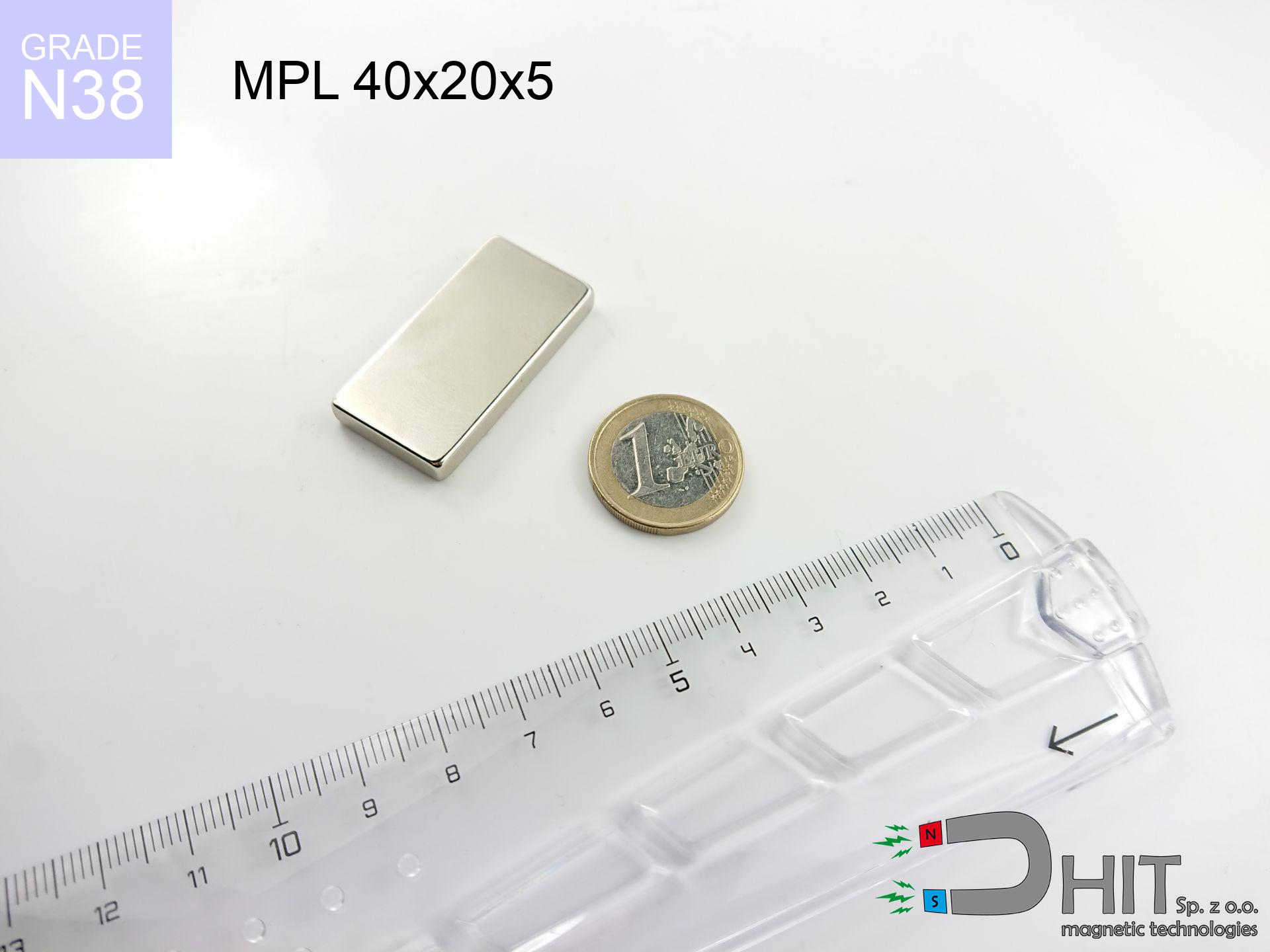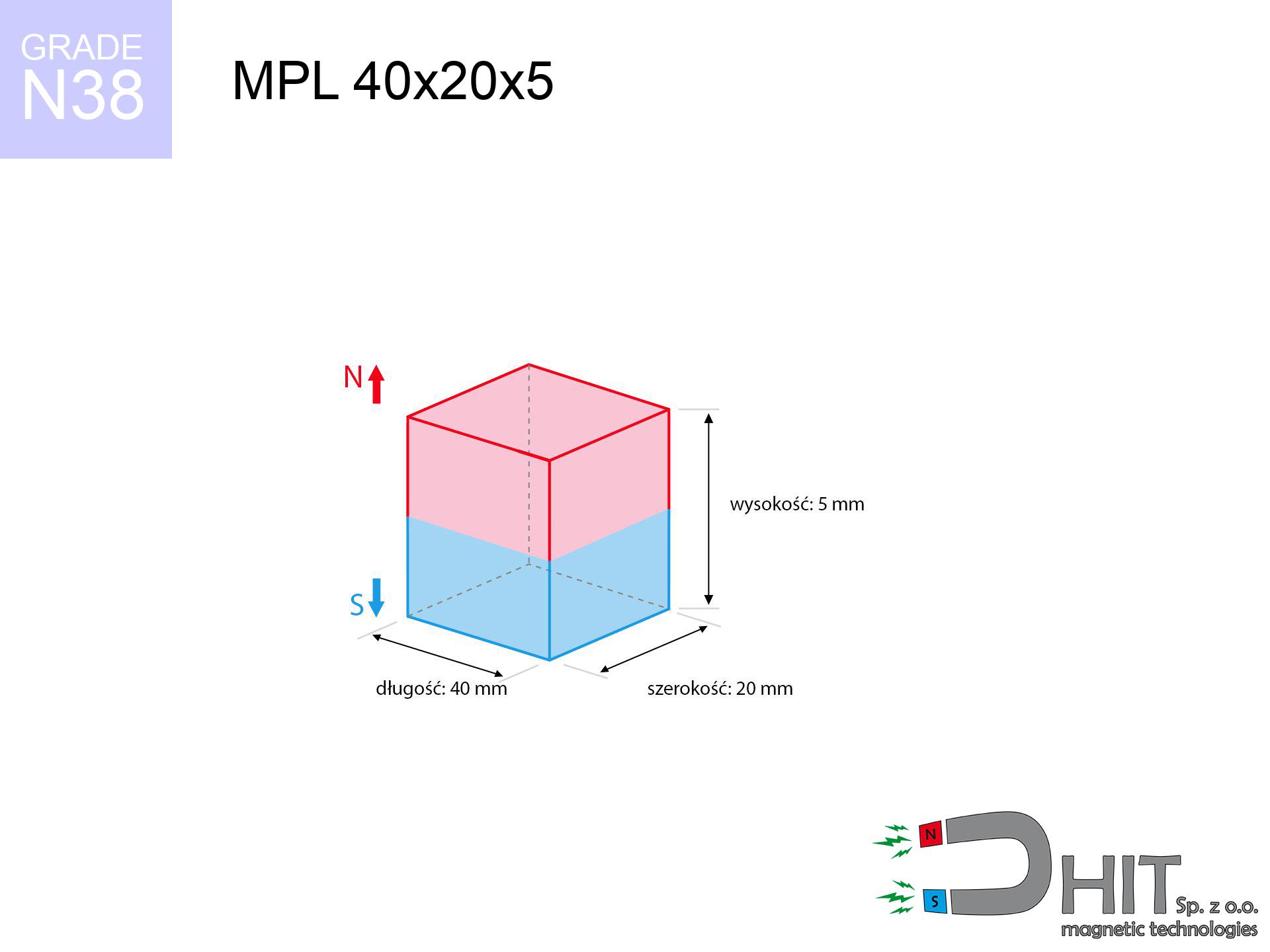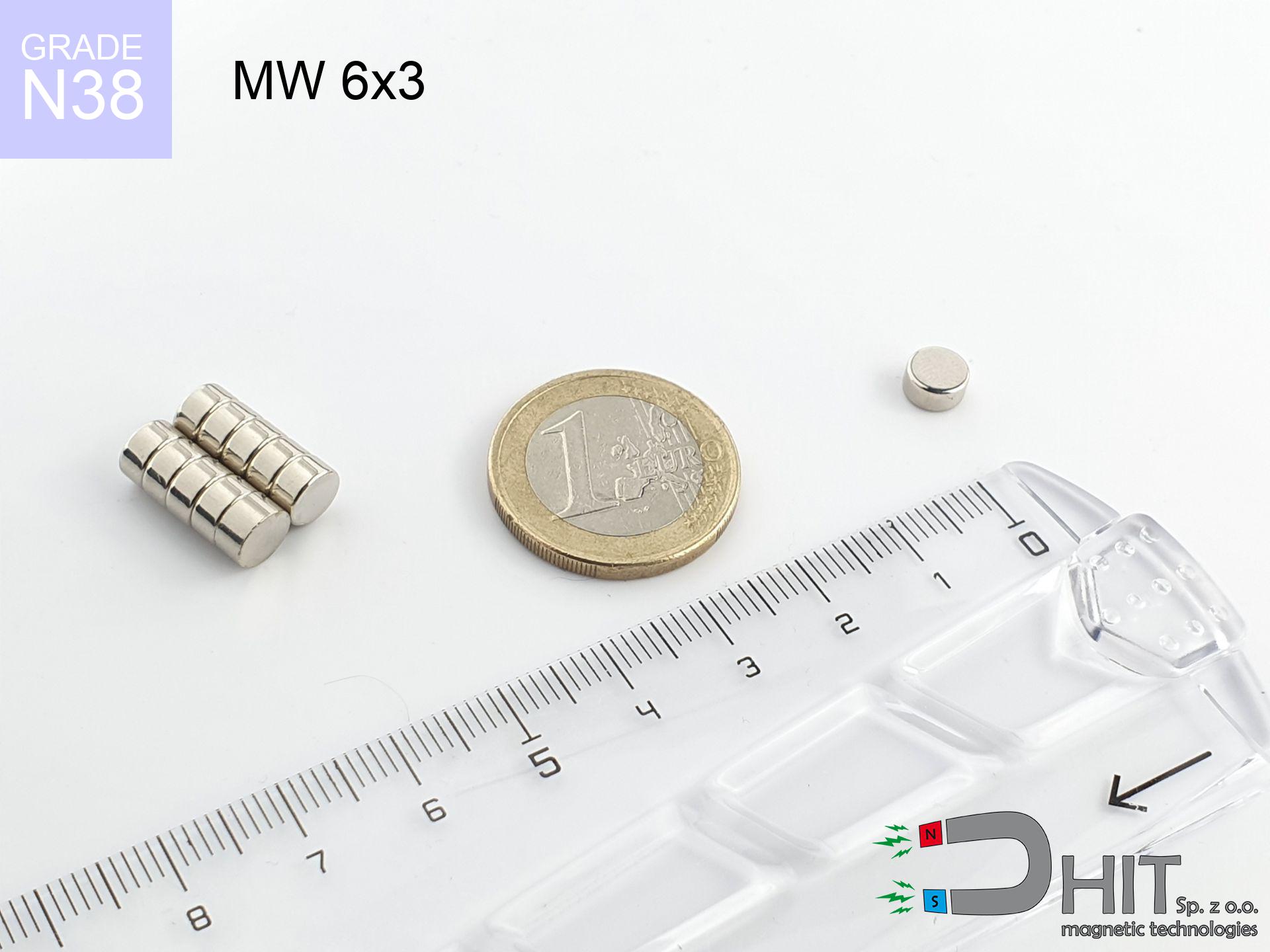MPL 40x20x5 / N38 - lamellar magnet
lamellar magnet
Catalog no 020160
GTIN: 5906301811664
length [±0,1 mm]
40 mm
Width [±0,1 mm]
20 mm
Height [±0,1 mm]
5 mm
Weight
30 g
Magnetization Direction
↑ axial
Load capacity
11.17 kg / 109.54 N
Magnetic Induction
205.27 mT
Coating
[NiCuNi] nickel
12.24 ZŁ with VAT / pcs + price for transport
9.95 ZŁ net + 23% VAT / pcs
bulk discounts:
Need more?Looking for a better price?
Give us a call
+48 888 99 98 98
if you prefer contact us via
form
through our site.
Force and form of magnets can be reviewed using our
our magnetic calculator.
Same-day shipping for orders placed before 14:00.
Magnetic properties of material N38
Physical properties of sintered neodymium magnets Nd2Fe14B at 20°C
Shopping tips
Pros as well as cons of NdFeB magnets.
Besides their magnetic performance, neodymium magnets are valued for these benefits:
- They have stable power, and over nearly 10 years their performance decreases symbolically – ~1% (according to theory),
- Neodymium magnets remain highly resistant to magnetic field loss caused by magnetic disturbances,
- In other words, due to the smooth surface of nickel, the element is aesthetically pleasing,
- Magnets are distinguished by very high magnetic induction on the outer layer,
- Made from properly selected components, these magnets show impressive resistance to high heat, enabling them to function (depending on their form) at temperatures up to 230°C and above...
- Thanks to the ability of accurate molding and customization to custom needs, NdFeB magnets can be produced in a broad palette of shapes and sizes, which amplifies use scope,
- Versatile presence in advanced technology sectors – they are used in hard drives, electric motors, medical equipment, also multitasking production systems.
- Compactness – despite small sizes they offer powerful magnetic field, making them ideal for precision applications
Disadvantages of NdFeB magnets:
- Susceptibility to cracking is one of their disadvantages. Upon strong impact they can break. We advise keeping them in a steel housing, which not only secures them against impacts but also increases their durability
- When exposed to high temperature, neodymium magnets suffer a drop in power. Often, when the temperature exceeds 80°C, their strength decreases (depending on the size, as well as shape of the magnet). For those who need magnets for extreme conditions, we offer [AH] versions withstanding up to 230°C
- When exposed to humidity, magnets usually rust. To use them in conditions outside, it is recommended to use protective magnets, such as magnets in rubber or plastics, which prevent oxidation and corrosion.
- We recommend cover - magnetic mount, due to difficulties in producing nuts inside the magnet and complicated forms.
- Health risk related to microscopic parts of magnets can be dangerous, if swallowed, which gains importance in the context of child health protection. Additionally, small elements of these magnets can disrupt the diagnostic process medical after entering the body.
- With mass production the cost of neodymium magnets can be a barrier,
Maximum magnetic pulling force – what it depends on?
Breakaway force was determined for the most favorable conditions, including:
- with the application of a sheet made of special test steel, guaranteeing maximum field concentration
- with a cross-section of at least 10 mm
- with an ideally smooth touching surface
- under conditions of no distance (surface-to-surface)
- during pulling in a direction vertical to the plane
- at room temperature
Practical lifting capacity: influencing factors
Holding efficiency impacted by working environment parameters, such as (from priority):
- Distance – existence of any layer (paint, dirt, gap) interrupts the magnetic circuit, which reduces power rapidly (even by 50% at 0.5 mm).
- Loading method – catalog parameter refers to pulling vertically. When attempting to slide, the magnet exhibits significantly lower power (typically approx. 20-30% of maximum force).
- Element thickness – for full efficiency, the steel must be adequately massive. Paper-thin metal restricts the lifting capacity (the magnet "punches through" it).
- Material type – the best choice is high-permeability steel. Cast iron may have worse magnetic properties.
- Plate texture – smooth surfaces ensure maximum contact, which increases force. Rough surfaces reduce efficiency.
- Thermal factor – high temperature reduces pulling force. Exceeding the limit temperature can permanently demagnetize the magnet.
* Lifting capacity testing was conducted on a smooth plate of suitable thickness, under perpendicular forces, however under shearing force the lifting capacity is smaller. In addition, even a slight gap {between} the magnet’s surface and the plate reduces the holding force.
Warnings
Safe distance
Intense magnetic fields can corrupt files on payment cards, hard drives, and storage devices. Maintain a gap of at least 10 cm.
ICD Warning
People with a pacemaker must keep an safe separation from magnets. The magnetism can disrupt the functioning of the life-saving device.
Dust explosion hazard
Combustion risk: Rare earth powder is highly flammable. Avoid machining magnets in home conditions as this may cause fire.
Conscious usage
Before use, check safety instructions. Uncontrolled attraction can break the magnet or hurt your hand. Be predictive.
Magnet fragility
NdFeB magnets are sintered ceramics, which means they are fragile like glass. Clashing of two magnets leads to them cracking into shards.
Danger to the youngest
Product intended for adults. Tiny parts can be swallowed, leading to serious injuries. Keep away from kids and pets.
Pinching danger
Large magnets can crush fingers instantly. Under no circumstances put your hand between two strong magnets.
Avoid contact if allergic
Studies show that the nickel plating (standard magnet coating) is a common allergen. For allergy sufferers, prevent direct skin contact and choose coated magnets.
Thermal limits
Regular neodymium magnets (N-type) undergo demagnetization when the temperature exceeds 80°C. The loss of strength is permanent.
Compass and GPS
GPS units and smartphones are extremely sensitive to magnetism. Direct contact with a powerful NdFeB magnet can permanently damage the internal compass in your phone.
Safety First!
Learn more about risks in the article: Magnet Safety Guide.





![SM 32x275 [2xM8] / N52 - magnetic separator SM 32x275 [2xM8] / N52 - magnetic separator](https://cdn3.dhit.pl/graphics/products/sm-32x275-2xm8-get.jpg)

![SM 32x350 [2xM8] / N42 - magnetic separator SM 32x350 [2xM8] / N42 - magnetic separator](https://cdn3.dhit.pl/graphics/products/sm-32x350-2xm8-nih.jpg)

